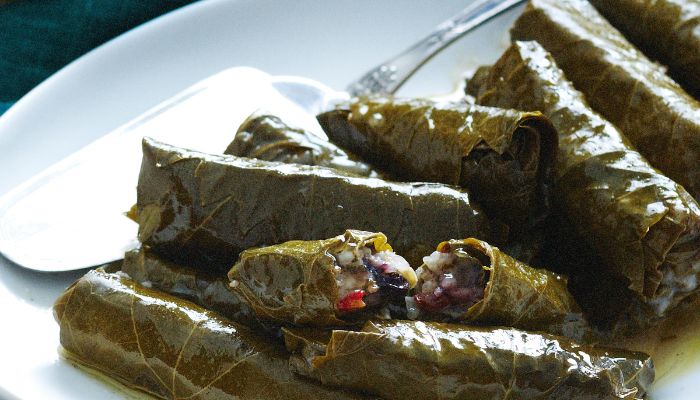This is best exemplified by the Turkish meal known as Stuffed Vine Leaves (Yalanc Zeytinyal Yaprak Sarma). Because it combines tasty ingredients with a fascinating history and several health benefits, this wonderful dish is a favorite among gourmets. An introduction to Stuffed Vine Leaves, the Yalanc Zeytinyal Yaprak Sarma recipe, a look at the dish’s health benefits, an analysis of the dish’s nutritional makeup, and arguments in favor of deciding to eat it will all be provided in this article.
Stuffed Vine Leaves: A Culinary Journey
Stuffed vine leaves are an ancient dish with variations across the Middle East, the Mediterranean, and the Balkans. The Turkish name for it is “Yaprak Sarma.” Wrapped in tender grape or vine leaves, the filling for this dish often consists of rice, ground beef, spices, and herbs.
The Turkish word “Yalanc” means “fake,” and while the traditional dishes usually involve meat, the “Yalanc” version is a delectable blend of rice, herbs, and spices that can be enjoyed by vegetarians and vegans.
Ingredients and Preparation for Stuffed Vine Leaves (Yalanc Zeytinyal Yaprak Sarma)
Ingredients:
- Thirty to Forty Grape or Vine Leaves, Fresh or Canned
- 14 cup of rice
- Finely chopped 1 medium onion
- Oil equivalent to 1/4 cup
- 1 tbsp. of tomato paste
- One tablespoon of dried mint
- 1 tablespoon of dried dill
- One teaspoon of ground black pepper
- Juice from a single lemon
- Extra salt
Preparation:
- In a bowl, mix together the rice, onion, olive oil, tomato paste, dried herbs, black pepper, and salt.
- Take a grape leaf, cut off the stem, and place it vein side up.
- Put some of the rice mixture in the center of a leaf, fold in the sides, and roll it up.
- The completed leaves should be planted in a container before continuing with the rest of the plant.
- Squeeze some lemon juice over the coiled leaves.
- Put a dish on top of the leaves and press down to prevent them from disintegrating.
- Just add enough water to cover the leaves and let the rice boil for 30–40 minutes, and it will be ready to eat.
- Don’t serve them just yet; let them cool down first.
Health Benefits and Drawbacks of Stuffed Vine Leaves
Eating packed vine leaves has several positive health effects. Yalanc’s version is great for vegans and vegetarians because it’s a good source of plant-based nutrients and includes no animal components. The dish’s potential benefits to cardiovascular health stem from its reduced saturated fat level. It aids digestion and keeps you feeling full longer thanks to its high fiber content.
As is always the case with delicious dishes, there are, unfortunately, some drawbacks. Olive oil is a healthy fat, yet it is often used liberally in Mediterranean cooking. Caution is advised due to the high sodium content of salt and preserved vine leaves.
Nutritional Value and Vitamins
The Yalanc variety of stuffed vine leaves is very nutrient-dense. The carbs in the rice they eat make them an excellent fuel source. Olive oil is used extensively in Mediterranean cooking because of its high monounsaturated fat content. Vitamin A, vitamin K, vitamin C, and iron are all present in the meal thanks to the vine leaves and herbs used to prepare it.
Why Choose Stuffed Vine Leaves?
The traditions involved in making and serving stuffed vine leaves are a priceless part of local culture that dates back hundreds of years.
Flavorful and Versatile: The combination of rice, herbs, and spices produces a one-of-a-kind taste. You can use it as an appetizer or a main dish.
In terms of vitamins and minerals, the Yalanc version provides 100% of the RDI for vegetarians and vegans.
The olive oil and plant-based ingredients featured heavily in this dish make it heart-friendly.
Conclusion
Yalanc Zeytinyal Yaprak Sarma is an outstanding example of the cultural significance, sweetness, and healthfulness of Stuffed Vine Leaves. It’s a dish with a deep history and excellent flavors, so it doesn’t just satisfy your taste buds; it also gives you a complete meal. You can try something new and improve your diet by making stuffed vine leaves.
FAQs
What are Stuffed Vine Leaves?
The dish known as “Yaprak Sarma,” which is stuffed grape or vine leaves, is a staple in the diets of people all over the world. Stuffing is typically made of rice, herbs, spices, and sometimes meat. The vegetarian “Yalanc” version substitutes rice and herbs for the meat.
What’s the difference between Yaprak Sarma and Yalancı Yaprak Sarma?
Vegetarians can enjoy Yalanc Yaprak Sarma, which is similar to the original Yaprak Sarma but is filled with rice, herbs, and spices instead of meat.
How do I prepare the vine leaves for stuffing?
Blanching fresh vine leaves in boiling water for one minute and then shocking them in cold water is a great way to soften them. Preserved leaves in salt or brine must be carefully rinsed before use.
Can I use different types of rice for the filling of Yalanc Zeytinyal Yaprak Sarma?
You can use any type of rice you choose, but the best results will come from using short- or medium-grain rice.
Is Yalanc Zeytinyal Yaprak Sarma suitable for vegetarians and vegans?
Absolutely. Vegetarians and vegans can take their fill of Yalanc Stuffed Vine Leaves without guilt because the filling is composed of rice and herbs rather than meat.
Can I make Stuffed Vine Leaves in advance?
You can prepare stuffed vine leaves in advance. After a day, the flavors have had a chance to really come together.
I hope you like reading about “Stuffed Vine Leaves – Yalancı Zeytinyağlı Yaprak Sarma Recipe.”

